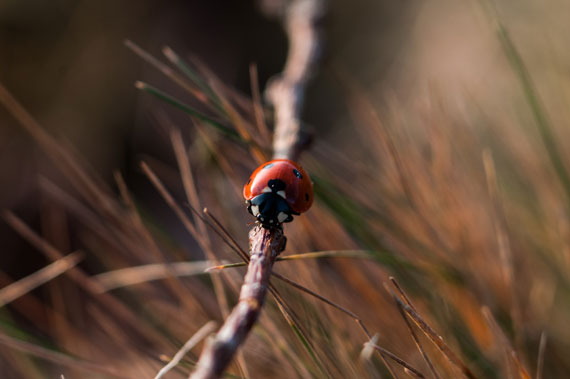One of the key markers of stunning macro photography is image sharpness. A little camera shake, too much depth, or an out-of-focus corner of the subject can really ruin an image. You want to get every detail, which requires an advanced understanding of your camera’s settings. Yes, including flash and focus bracketing — which Andrew Lanxon shares tips on how to master in this video tutorial!
Front and Backlighting
Natural light can be unpredictable and fleeting. That’s why Andrew packs a small aperture LED panel for outdoor macro shoots. It helps give that extra boost, subtly illuminating subjects, especially in the undergrowth or darker areas. As it’s hand-held, you can shine it in various directions, which helps if your subject is placed awkwardly.
Andrew also takes his Godox AD200 pocket flash with him. You can use a light like this to backlight your subjects, creating a sunny effect. Or to illuminate them from various angles so as to stack the images later on.
…it acts as a lovely backlight, adding a great pop of light behind that mushroom. And that kind of gives it the effect of the sun breaking through the clouds over head and maybe coming in through the trees…
Stabilization
Andrew advises you always take a tripod on macro shoots to reduce camera shake. You can use a tripod to brace the camera in awkward positions, such as facing straight down. His favorite macro photography tripod can also invert its center pole downward, allowing him to take stable undergrowth shots.
Arguably, exactly where the best macro subjects, like mushrooms and flowers, are usually found. Andrew’s camera also has a flip screen, which can accommodate these “weird” angles a bit better than a standard built-in screen.

Maco photo captured by Timo Vijn
Misting
When packing for a shoot, a spray bottle with water may not be your first thought. However, Andrew (almost) never forgets his when shooting macro photography — particularly in forests. Mist it to simulate light rain or fog, transforming shots into something magical. Ideally, spray the bottle over the subject while also backlighting it for the best results.
Autofocus Bracketing
Using your AF bracketing feature allows you to take multiple images with various AF points automatically. This feature is available on the Canon R5 — Andrew’s chosen camera body for this tutorial — as well as most mirrorless and modern DSLRs. However, AF bracketing settings will vary per camera, so do find out more about what your model can (or can’t) do.
To use AF bracketing, set it up in your camera menu. Also, make sure to switch on Autofocus on your lens. You want to take as many shots as possible for macro subjects. Some composite images require up to 100 separate images to create. As missing one area can result in a composite with blurry spots, you also want to set all AF points.
You can usually set them in even increments in the AF bracketing menu. Plus, the number of shots the camera takes here, as well. These extra features are particularly useful if you’re using a tripod like Andrews. With your camera upside down or sideways, it’s really difficult to auto-focus — or even press your shutter, for that matter!
Image Stacking
Once you have a selection of images of your subject, you’ll need to use post-production editing software to merge them. Andrew first imports his images into Lightroom, then adjusts the lighting of one and syncs the settings across the whole set. Then he exports the images as TIF files for the next stage.
His preferred software for creating composites is Helicon Focus, which is designed specifically for stacking macro images. Andrew uses Method B, which easily renders and stacks multiple images, automatically rendering a composite for him.
Wrapping Up
When shooting any subject, there are specific techniques you can apply to get the best results. In the case of macro photography taken outdoors, minimizing shake and maximizing detail is key. Techniques such as image stacking, backlighting, and even Andrew’s favorite — misting, can level up a macro photograph noticeably.
Like This Article?
Don't Miss The Next One!
Join over 100,000 photographers of all experience levels who receive our free photography tips and articles to stay current:





